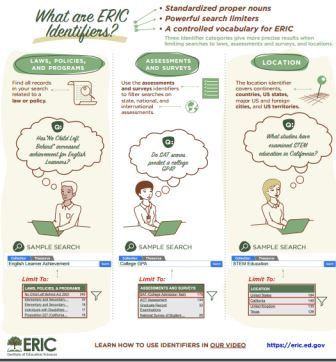ERIC has made recent improvements to help searchers find the education research they are looking for. One major enhancement relates to the ERIC identifiers, which have been improved to increase their usefulness as search tools. It is now easier than ever to refine searches to obtain specific resources in ERIC.

The identifier filters can be found on the search results page in three separate categories: (1) laws, policies, and programs, (2) assessments and surveys, and (3) location. After running a search on an education topic, users can scroll to the category on the left of the results page, select the desired identifier limiter within a category, and limit the results to only those materials tagged with that identifier.
We recently released a video that describes the enhanced identifiers, and walks through how to best use them to find materials in the ERIC collection. (We've embedded the video below.)
Using the improved identifiers, searchers are now able to find materials related to specific locations, laws, or assessments no matter how the author referred to them in the article.
In other words, identifiers can now be used as an effective controlled vocabulary for ERIC, but this has not always been the case. While they have been part of ERIC since 1966, identifiers were not rigorously standardized, and they were often created "on the fly" by indexers. Also, the previous identifiers field had a character limit, meaning that some terms needed to be truncated to fit into the space allowed by the available technology. Therefore, over time, the identifiers proliferated with different spellings, abbreviations, and other variations, making them less useful as search aids.
To solve these issues, we launched a project in 2016 to review the lists of identifiers, and devise an approach for making them more user-friendly. Our solution was to streamline and standardize them, which eliminated redundancy and reduced their number from more than 7,800 to a more manageable 1,200. We also added the updated identifiers to the website’s search limiters to make them easier to use.
In addition to our new video, which demonstrates the best ways to use identifiers in your search, we also have a new infographic (pictured above) that depicts what identifiers are. You can use these companion pieces to learn more about identifiers, and begin putting them to work in your research.